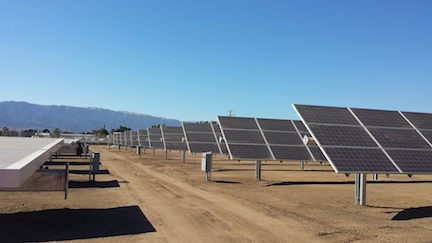Company at a glanceName: Tennessee Valley Infrastructure Group (TVIG), a wind producerHeadquarters: 1200 Mountain Creek Roadin ChattanoogaStaff: About 30 employeesHistory: Started in 1998 by Rick Hector, former TVA and U.S. State Department officer. Wind energy added two years agoSolar division: American Helios ConstructorsCEO: Peter F. de Vos
The world's most powerful military is trying to use less power, at least from conventional, vulnerable means.
The U.S. Army, Navy and Marines are turning to the sun, the wind and simple conservation to cut the military's $21 billion annual energy bill and to limit the need for costly fuel shipments around the globe.
A Chattanooga energy company is among the biggest beneficiaries from the military maneuver. The Tennessee Valley Infrastructure Group, a Chattanooga-based wind and solar energy developer, has already built the biggest wind power installation at a military installation in Texas. TVIG's sister solar energy firm, American Helios Contractors, is also building the biggest military solar array in Arizona.
"We are uniquely positioned as a company with a long history of wind and, more recently, solar installations around the globe." said Rich Jordan, director of business development for TVIG. "We are also headed by a disabled veteran and qualify as a small business -- two categories the military is trying to award more contracts to for its work."
The federal government has set a goal for the Department of Defense to get at least 25 percent of its power from renewable sources by 2025. The target was set after the military determined that wind, solar, conservation and other renewable sources could help not only save money but reduce the military threat caused by having to ship so many fuels to bases around the world. In Iraq, nearly one of every 24 fuel distribution trucks was attacked and destroyed.
A Defense Science Board study in 2008 examined the energy use in the Iraqi and Afghanistan wars and suggested that new sources of energy would help both the security of the U.S. operations and the economic and environmental costs of war.
Even at military bases at home in the United States, renewable energy could help provide greater energy security by reducing dependence upon the commercial electric grid, which could be attacked by terrorists or hurt by adverse weather.
In 2012, military bases in the United States suffered 87 power outages of more than eight hours that collectively cost more than $7 billion.
"That's why DOE is paying a lot more attention to energy and all of the service branches are trying to do something about it," said Phyllis Cuttino, director of the clean energy program for the Pew Charitable Trust and author of a recent report on how the military is using renewable energy.
The Department of Defense grew the total value of its energy savings performance contracts from renewable energy projects from $277 million in 2010 to $411 million in 2012. The military has set a goal of getting from renewable energy generation at least 3 gigawatts -- equal to about 10 percent of the capacity of all of TVA's power generation -- by 2025.
"That's a substantial amount of power for renewable energy producers to meet, and the military also is a great test bed to try out renewable energy in a variety of settings, often under some adverse conditions," Cuttino said.
While most of TVIG's business has come from utilities, power coops and others in the electricity market, TVIG expects to grow both wind and solar installations it builds at military bases, especially since the Chattanooga company qualifies under government procurement rules as both a small business and a business headed by a disable veteran.
Peter de Vos, a former head of U.S. investment banking for RBC Capital Markets who previously served in the nuclear navy where he injured his knee, is chairman and CEO of TVIG. He joined the company after his former roomate at the Naval Academy, TVIG founder Richard Rector, convinced him of the growing market potential from TVIG.
TVIG began in Chattanooga in 1998 building power generators and windmills, primarily in Third World countries that otherwise had no power. The company has grown into one of the top 10 wind energy builders in America and the company expanded two years ago into solar energy.
As a disabled veteran, de Vos can now qualify TVIG and American Helios for the government's small business, veteran and disabled-owned contractor preferences.
Earlier this summer, TVIG finished building the largest wind farm on a government facility at the Department of Energy's Pantex Plant in Amarillo, Tex. The $10 million project, built by TVIG and developed and owned by Siemens Government Services, is for 11.5 megawatts.
The completion of the Pantex wind farm came just a couple of months after TVIG's sister firm broke ground in April for the biggest solar array at a government facility. American Helios is building an 18-megawatt solar farm at Fort Huachuca near Tuscon, Ariz., capable of supplying about 25 percent of the annual electricity requirement at the Army base.
De Vos said such military projects, along with growing interest in renewable energy by power utilities and high-energy use industries, "create a tremendous opportunity for our continued growth."
"We're not going to be the biggest player in this market, but we think we can do well with the markets that are coming down the line -- both on the commercial and military sides" he said.
Contact Dave Flessner at dflessner@timesfreepress.com or 757-6340.

